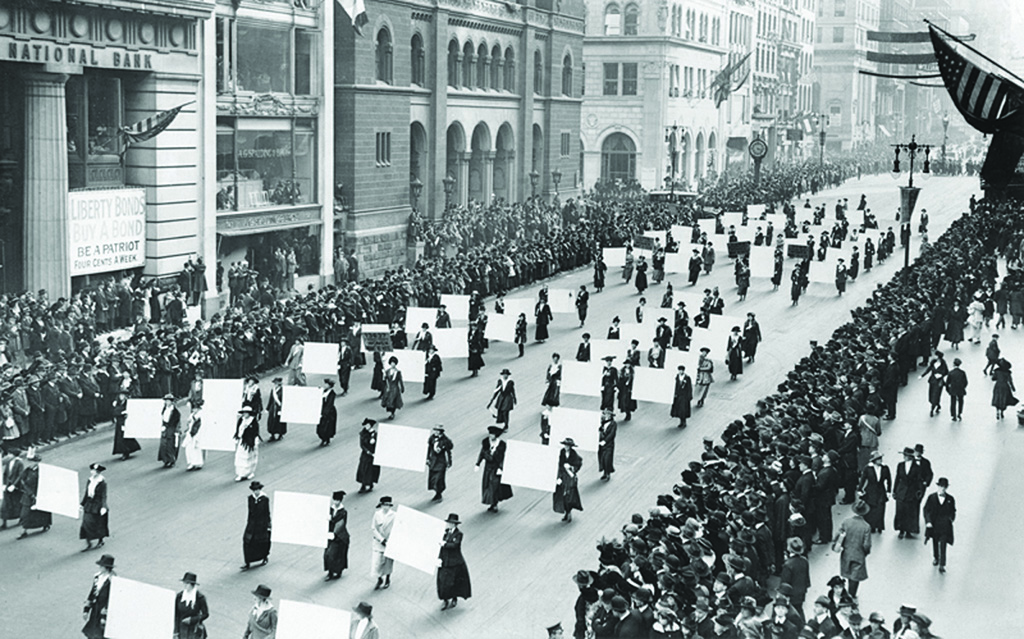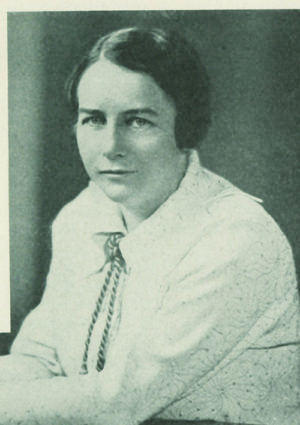Forward Through Darkness, Forward Into Light

Celebrating the Women’s Vote Centennial
by Mariellen Sasseen, Alpha Delta (U of Alabama), Director of Communications/Editor
Throughout 2019-2020, the US has been celebrating the 100th anniversary of the 19th Amendment giving women the constitutional right to vote. Led by the Women’s Suffrage Centennial Commission, the US Congress has designated August 2020 as National Women’s Suffrage Month. The culmination of this celebration will occur on August 26, the same date the 19th Amendment was ratified in 1920. On this day, state capitols, skyscrapers, bridges and city halls all across the country will light up in official suffrage colors of purple and gold to recognize this historic milestone and honor the suffrage slogan, “Forward through the Darkness, Forward into Light.”
The Fight Of Their Lives
It’s appropriate to reflect on the long and frustrating process that led to women in the US earning the right to vote and catching up with Canadian women who, province by province, began earning the same privilege in 1916. Though many of the early suffragists never lived to see their efforts succeed, generations who have followed continue to reap the benefits of their efforts. The fight that began by suffragists in the mid 1800s was during a time when women were little more than second-class citizens. Because they were deemed intellectually inferior to men, they were expected to claim the thoughts and opinions of their husbands and were discouraged from pursuing serious education. After marriage, a woman did not have the right to own property, maintain a wage, sign a contract or vote. Their expected place was in the home raising children.
In 1840, two American women, Lucretia Mott and Elizabeth Cady Stanton, attended the World Anti-Slavery Convention in London and were outraged over being seated in galleries just because they were women. Upon their return to the US, they organized their own convention to discuss the social, civil and religious rights of women and crafted their Declaration of Principles that outlined the inequalities for women. Resolution 9 of this document, modeled after the Declaration of Independence, boldly requested the right to vote for women and eventually became the centerpiece of what would become the women’s rights movement in the US. In 1848, the movement was officially set in motion with the first Women’s Rights Convention in Seneca Falls, New York.
The Canadian Vote
In Canada, women such as Dr. Emily Stowe led a suffrage campaign of petitions, lectures and demonstrations that spanned more than four decades. Undeterred by public opinion and hostile politicians, these women overcame enormous obstacles. Manitoba was the first province to allow Canadian women to vote in 1916. Saskatchewan and Alberta were soon to follow. While it took several decades before all provinces joined Manitoba’s lead, the Canada Elections Act enfranchised Canadian women 21 years of age and over for federal elections on May 24, 1918, with an effective start date of January 1, 1919. While many Black women were granted voting access by province between 1916 and 1918, restrictions remained in some areas.
One War At A Time
Major setbacks were encountered in the form of the Civil War and national attention was diverted to another important movement – the abolition of slavery. Hoping both slaves and women would be given the same rights as white males after the war, women such as Stanton and Susan B. Anthony also worked tirelessly for the emancipation of enslaved people. Unfortunately, in the end, the government determined the rights of women and enslaved people were two separate issues and advanced the cause of abolition without addressing the women’s cause. President Lincoln famously said on the subject, “One war at a time, so I say, one war at a time.” Anthony questioned back to Lincoln, “May I ask just one question based on the apparent opposition in which you place the Negro and the woman? Do you believe the African race is composed entirely of males?”
When the 14th Amendment was ratified in 1868, women activists were enraged because it defined citizenship and voters as “male,” and raised questions about whether women were considered American citizens at all. In 1870, the 15th Amendment was ratified, granting the right to vote to African American men. For the next two decades, internal strife existed between two women’s rights movements, the National Woman Suffrage Association (NWSA) in New York and the American Woman Suffrage Association (AWSA) in Boston but eventually led to the National American Woman Suffrage Association (NAWSA) led by one of the prominent early suffragists, Elizabeth Stanton.
Votes For Women
For 72 years, women leaders lobbied, marched, picketed, and protested for the right to the ballot. The U.S. House of Representatives finally approved the Susan B. Anthony Amendment, which guaranteed women the right to vote, on May 21, 1919. The U.S. Senate followed two weeks later, and the 19th Amendment went to the states, where it needed to be ratified by 3/4ths of the-then-48 states to be added to the Constitution. By August, the Amendment had passed 35 of the 36 states needed but suffragists were concerned because the remaining states all appeared to be adamantly opposed.
Hope rested on Tennessee where a bitter clash was raging between the “pro” supporters and the “anti” supporters. The conflict would become known as the “War of the Roses.” 24-year-old Senator Harry Burn, who was expected to vote no, brought the vote to a nail-biting tie after following the advice of his mother. He explained that his last-minute change of heart was due to a telegram he received from his mother urging him to “…vote for suffrage and don’t keep them in doubt. With lots of love, Momma.” With Burn’s “aye” vote the crowd erupted, but a tie vote still wasn’t enough for passage. Banks Turner, a legislator who had earlier abstained then stood to cast the final “aye” vote in dramatic fashion, making Tennessee the last state to ratify the 19th Amendment on August 18, 1920. The 19th Amendment was officially ratified nationally by President Woodrow Wilson on August 26, 1920.
Clarification Of Privilege
While the ratification of the 19th Amendment was cause for great celebration, it did not end the struggle for Black women, particularly southern women, who continued to face racial barriers to vote. The 15th Amendment, which had passed back in 1870, may have prohibited the federal government and individual states from denying a citizen the right to vote based on race or color, but did not prevent states from using poll taxes, literacy tests, fraud, and intimidation to prevent Black citizens from voting. It wasn’t until the passage of the Voting Rights Act of 1965 that these practices were outlawed. This act opened the doors for the African American population to finally register and vote. According to the US Department of Justice, the Act is considered to be the most effective piece of federal civil rights legislation ever enacted in the country. Sadly, seven years ago, the Supreme Court effectively struck down the law’s key enforcement provision – freeing certain states from having to get approval for voting rule changes. Voting rights activists are working to restore the powers of the Voting Rights Act, but much work is still left to be done. The recent death of civil rights activist, Representative John Lewis, has intensified those efforts for others fighting for the same cause he was so passionate about.
An AOII In The Room Where It Happened

Learning of the upcoming ratification vote, AOII’s Lucy Somerville Howorth, Kappa (Randolph-Macon Women’s College) did not want to miss her opportunity to hopefully watch history being made. On August 18, 1920, she drove with her mom from Mississippi to Nashville in order to be in the room for the ratification of the 19th Amendment. Lucy took great inspiration from this moment and went on to become a successful judge. She was the first woman to serve as top legal counsel to any executive or administrative agency of the Federal Government and the first woman to chair the Mississippi State Board of Law Examiners. Her mother was the first woman elected to the Mississippi House of Representatives and Lucy followed in her mother’s footsteps by serving as a member of the Mississippi State Legislature. This impressive sister also served AOII lovingly through the years as a member of the Executive Committee (now Executive Board) and on numerous committees. Before her passing in 1997, AOII presented her with the 1985 Elizabeth Heywood Wyman award that recognizes outstanding success in a profession, the arts or service to humanity.
Illuminating History
Alpha Omicron Pi will be proudly participating in the “Forward Into Light” Women’s Vote Centennial Campaign on August 26, 2020 by lighting up AOII International Headquarters in purple and gold, the official colors of the suffrage movement. AOII’s Brentwood, Tennessee HQ will be one of many landmarks, such as city halls, state capitals, bridges and sky-scrappers, all across also the country participating in this historic salute. Watch for photos of our participation on social media.
Feature photo: Suffragists parade down Fifth Avenue, 1917. Advocates march in October 1917, displaying placards containing the signatures of more than one million New York women demanding the vote. The New York Times Photo Archives

